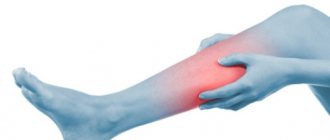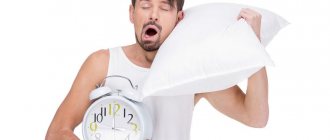Attacks of intense causeless anxiety are always accompanied by various respiratory disorders. The feeling of suffocation, shortness of breath, the feeling of incomplete inspiration - all this is well known to patients who regularly suffer from PA. It is known that such disruptions in breathing provoke increased anxiety, as a result of which it becomes much more difficult for the patient to calm down. Therefore, learning how to breathe correctly during a panic attack is very important.
Video - 1 simple breath for excitement, anxiety, panic attacks and pressure
For gymnastics to have a positive impact, it must be done correctly:
- Breathe through your nose. This way the air is heated, humidified and purified. If oxygen enters through the mouth, harmful elements and dust enter the lungs.
- Take full breaths. The process involves: the chest, diaphragm and muscles of the anterior abdominal wall.
- Inhale and exhale correctly. Gymnastics for VSD involves inhaling, during which the chest first expands, and then the abdominal muscles. During exhalation, the stomach first contracts, and then the chest narrows.
- Synchronize movements and breathing. As you inhale, your arms spread to the sides or rise. Exhalation is accompanied by squatting, bending or bringing your arms together.
- Complement breathing exercises with sports. Yoga, aerial yoga, Pilates and exercise therapy for VSD help relieve spasm of the spinal muscles, thereby having a beneficial effect on the supply of oxygen.
Good results only appear if you practice regularly.
Vegetative-vascular dystonia is accompanied by attacks of suffocation, shortness of breath, and lack of oxygen. Hypoxia causes disturbances in heart rhythm. With pathology, patients experience increased blood pressure, dizziness and lightheadedness. A symptom complex appears when a person’s nervous system is excessively anxious; the patient needs to eliminate oxygen starvation.
In order to eliminate attacks in the initial stages of the pathological process, you should not immediately use antidepressants and other potent medications. The patient is advised to stabilize respiratory function. For this purpose, a set of exercises is performed. Thanks to special breathing, the body is saturated with oxygen, which leads to the normal functioning of the brain and heart.
During the period of gymnastics, the chest is completely filled with oxygen. When performing exercises, it is recommended to use the lungs, diaphragm and abdomen. During the manipulation, you need to set the breathing rhythm. It should be synchronous with physical activity. When performing the manipulation, it is recommended to inhale through the nose and exhale through the mouth.
If a person strictly adheres to the principles of doing gymnastics, this will have a positive effect on the result.
In order to improve breathing with vegetative-vascular dystonia and the patient’s condition in general, daily implementation of the basic complex is recommended:
- The first exercise is quite simple. It consists of rhythmically inhaling and exhaling several times. When performing the manipulation, it is recommended not to open your mouth. Next, you need to take several breaths in and out with your left nostril closed. At the next stage, the manipulation is repeated with the right nostril closed.
- Breathing is carried out using the abdominal muscles. When inhaling through the nose, the abdomen is rounded as much as possible. When you exhale, you need to draw it in.
- When inhaling, the stomach remains motionless. In this case, you need to work with your chest. The air is released through the nose.
- The next manipulation involves inhaling, during which the lungs expand and the stomach rounds. When exhaling smoothly, the abdominal wall is initially drawn in, and then the chest. When performing the exercise, one hand should be on the stomach and the other on the chest.
- When air is inhaled, the lungs expand and the abdomen retracts. When you exhale, the chest retracts and the stomach rounds. Breathing is carried out through the nose.
- The breathing rhythm is gradually slowed down, and after that it is smoothly and evenly increased to normal.
- At the next stage, a combination of breathing exercises and physical activity is recommended. The patient should walk slowly while maintaining proper breathing. When performing the exercise, you need to ensure that walking and breathing are synchronous. The duration of the manipulation is several minutes.
- The exercise is performed in a standing position. Your feet should be placed together and your hands should be at your sides. As you exhale, it is recommended to raise your arms up to the sides, and as you exhale, lower them.
- The next manipulation involves rotating your arms at your shoulders while breathing voluntarily. The movements should be performed back and forth.
- At the final stage, slow nasal breathing is performed. After this, it delays for a few seconds and resumes again.
A set of exercises will bring a positive result in treatment only if it is performed correctly. To avoid the development of complications, the patient is recommended to first consult with a doctor.
The sensations with vegetative-vascular dystonia are not the best. An attack of this disease occurs due to anxiety, stress, and physical exertion. One of the unpleasant sensations is difficulty breathing, a need for air, perhaps even asthma-like suffocation, accompanied by rapid, shallow breathing. The surrounding world may also be spinning, the anxious emotional state is aggravated by the fear of losing consciousness from possible suffocation.
Modern medicine speaks of the psychological origin of these problems. The patients do not have asthma or dystonia; it is a neurosis based on a panicky fear of suffocation. However, you need to overcome this fear, because there have been no cases of death from attacks of VSD, which means that it is quite possible to fight them with independent training, including breathing exercises that will help.
Doctor Kurpatov highlights the features of the anxiety state associated with lack of air:
- if the patient does not have enough air, he must understand that everyone around him has enough and calm down;
- if there is a suspicion of bronchial asthma, but the doctor does not see visible signs, then the problem is of a psychological nature, this also needs to be taken into account by the sufferer of VSD;
- if after a cardiogram the diagnosis of atherosclerosis of the coronary vessels is not confirmed, then shortness of breath is a subjective sensation;
- The professor also touches on the fear of death that visits a patient during an attack of VSD - he claims that even if breathing is interrupted, the body’s defensive reactions will not allow the body to die.
So you need to learn to calm down and breathe correctly, including during attacks of VSD.
It is better, of course, not to pay attention to breathing and live a full life. But if there are malfunctions in the human respiratory system, and even against the background of VSD, then you need to learn the basic principles of proper inhalation of air:
- not only the chest breathes, but also the diaphragm, as well as the muscles of the anterior abdominal wall; when a person inhales air, first the lungs expand, then the chest increases, and then the abdominal wall moves forward; accordingly, exhalation occurs in the reverse order;
- If possible, you need to breathe only through your nose - this way the air is moistened, purified and warmed; only in case of heavy physical exertion is mouth breathing possible;
- you need to breathe according to the movement - the body instinctively exhales when squatting, when the arms go down, inhalation is done when straightening the torso, weights are lifted as you inhale.
If, in case of breathing problems that affect the well-being of VSD, you correctly synchronize breathing and the physical state of the body, then you can achieve relief by strengthening the body and coherence of vital processes. Simply put, exercise will prepare you for an improved quality of life.
- fatigue, lack of strength;
- general weakness of the body;
- irritability, emotionality, tearfulness;
- sleep disorders;
- frequent headaches in the temporal part, temporo-frontal and temporo-parietal;
- strong weather sensitivity;
- panic fears, anxiety;
- feeling of a “lump” in the throat;
- frequent urination;
- pain in the heart area caused by lack of air.
If you experience at least two of these symptoms, breathing exercises will help you gain strength and vigor.
If the breathing technique is incorrect, unpleasant symptoms may appear, which will only aggravate an already poor state of health. There are direct symptoms of VSD that indicate improper breathing:
- lack of oxygen, inability to breathe deeply;
- lump in the throat;
- constriction in the chest.
In addition to direct signs, there are indirect signs:
- chest pain in the heart area;
- dizziness and possible loss of consciousness;
- arrhythmia and tachycardia;
- insomnia;
- disturbance of the psycho-emotional system;
- poor blood circulation in the body.
In addition to the technique described above, there are several more ways to normalize breathing during VSD. The famous cardiologist Kurpatov developed his own system that helps quickly eliminate unpleasant symptoms. Its essence is to create a minimum pause between exhalation and inhalation.
The doctor claims that it is during this short period that fear is formed, which provokes a panic attack. To overcome it, you need to act according to the following scheme:
- The breathing process is divided into three phases: inhalation, retention and exhalation. In the first stage, each of them lasts five seconds.
- In the next phase, the duration of inhalation remains the same, and the pause is already four seconds. The duration of exhalation increases by a second.
- Next, with each cycle you need to add one second to the exhalation, shortening the pause by the same amount. The result should be a ratio of 5 to 10.

An excellent option for normalizing the emotional state and respiratory function is an exercise for vegetative-vascular dystonia, which involves working with sound. To do this, you need to inhale for seven seconds with an exhalation of the same duration, during which the sound “and” is pronounced. Many experts compare this practice with meditation and note its positive effect on the functioning of the central nervous system.
It is possible to replace the sound “and” with the following options:
- To achieve a stable heart rhythm and reduce the manifestations of tachycardia, the “o” is extended.
- The sound “a” helps improve blood circulation.
- For general strengthening of the body, it is necessary to pronounce “m” or “w” as you exhale.
iHerb
Neuroses.
Neuritis. Depression Neuroses are a group of diseases based on temporary reversible disturbances in mental activity. According to I.P. Pavlov, neurosis is a breakdown of higher nervous activity.
A neurotic breakdown can occur in any person in a prolonged traumatic situation, but its nature and form are closely related to individual predisposition and personality characteristics.
Frequent causes of neurotic disorders are chronic emotional stress, prolonged physical or mental fatigue.
Unfortunately, not every person manages to “extinguish” irritation and anger in time, pull himself together and switch to creating a calmer and more favorable environment.
In addition, it is impossible to instantly get rid of the asthenic syndrome that has accumulated over the years, in which there is weakening of attention, memory deterioration, decreased physical and mental performance, increased fatigue and irritability, emotional instability with sudden mood swings and, finally, headaches.
Strelnikovsky breathing exercises can radically change your mood in just half an hour - you will want to run, dance, sing, laugh and enjoy life! Why is it referred to as acting gymnastics? Yes, because she is extremely popular among actors.
In a matter of minutes (actors often do it right before going on stage, standing behind the scenes in makeup and costume), it creates a special psycho-emotional state in which courage and self-confidence appear, a feeling of freedom and emancipation throughout the body, and a colossal emotional surge.
I can’t say exactly what happens during exercise in the brain at the cellular level (this is a task for future research), but I think that all centers located in the cerebral cortex are actively involved in metabolic processes. Gymnastics has a particularly strong effect on the center of joy, pleasure and other positive emotions.
I always say this to my patients at the clinic: “Are you suffocating? Come see me for a breathing exercises session.
Do you have heart pain, liver pain, high blood pressure, headache? Crawl to Strelnikova’s gymnastics with me!” Because I know: no matter how bad a person’s condition is (if he is, of course, able to move), I will give him a forty-minute “doping” in the form of 1500–2000 breaths and movements.
One day, a 45-year-old patient being treated for bronchitis said: “Last night my husband came home drunk again and began to rage, as always. Well, we got into a fight with him... The scandal was enormous, almost to the point of a fight! I run out to the kitchen, I’m shaking all over with resentment, I don’t want to live.
I open the window (we live on the ninth floor), but... I don’t throw myself out, but start doing your gymnastics.
After 10 minutes of “pumping up” I am calm as a boa constrictor, my mood is excellent, life is wonderful! And I think: “My God, just a few minutes ago I wanted to jump out of the window! Because of whom? Because of this drunk? God bless him!” And such cases are not uncommon in my practice.
Neurasthenia, which arises as a result of exhaustion of the nervous system, gradually recedes with regular exercises in Strelnikov gymnastics without the use of tranquilizers and psychotherapy.
Neurotic depression is somewhat more difficult to treat , in which the patient experiences a low, depressed mood and an oppressive, hopeless melancholy. He perceives everything around him in a gloomy light.
All past grievances and misfortunes come to mind, and the future seems hopeless. Such patients sit all day long in a monotonous position, with their heads bowed low with a mournful expression on their faces, or lie in bed.
They experience increased irritability, tearfulness, and apathy, accompanied by decreased appetite and sleep disturbances.
It is very important that during this period there is a close, loving person next to such a patient who, with a caring and affectionate attitude, would help him quickly get out of this state.
It is necessary that a patient suffering from depression engage in Strelnikov breathing exercises daily and preferably in a group.
A person studying in a group is involuntarily distracted from dark thoughts. He sees how other patients (heart patients, asthmatics, hypertension, stutterers, etc.) with each session improve their well-being and mood, increase their vitality and gain confidence in a complete recovery.
Since my sessions often involve actors and singers working on their voices, I put them together with the rest of the patients.
At the end of the lesson, I also give the actors and singers special vocal exercises, which are often performed by all the patients present at the lesson - and everyone’s mood lifts.
Facial neuritis often occurs after various infections. With this disease, muscle paralysis develops on the corresponding side of the face, and the mouth skews towards the healthy side. The patient cannot wrinkle his forehead or close his eyes, which causes him a lot of inconvenience and suffering.
Early in my medical practice, I treated patients with facial neuritis. I remember a middle-aged woman whose face was distorted. By the end of the first session (40–50 minutes after the start of the workout), it became absolutely symmetrical.
The next day she came to class again with a distorted face, but by the end of the session the asymmetry had disappeared again. And this went on for several days: she came with a distorted face, and left as a pretty woman.
After several sessions, her face finally acquired a normal expression, and she was soon discharged.
Before discharge, I strongly recommended that the patient do breathing exercises daily for 10–15 minutes, and in case of relapse of the disease (new “distortion”), contact me. But she never called again, and I don't think there was any need to do so.
With the help of Strelnikov gymnastics, it was repeatedly possible to completely eliminate various twitching of the eyelids and facial muscles (as a rule, teenagers, young men and young men suffer from this - during the entire period of work, only males turned to me for help). With this pathology, it was not difficult to return young people to normal facial expressions.
In such cases, I recommend that patients do more of three head exercises: “Head turns”, “Ears” (“Ah-ay”) and “Pendulum with the head” (down-up).
Start your lesson with these exercises (96 breaths-movements each) and end with them (another 96 breaths-movements each) - in total you will get two “hundreds” for each of these exercises. This does not mean that for these diseases you should only do them.
The whole complex is necessary, and these exercises must be done at the beginning and at the end.
Among diseases of the musculoskeletal system, the most severe in terms of course and consequences is coxarthrosis. Since it is based on a metabolic disorder and poor circulation in the hip joint, Strelnikova’s gymnastics can significantly alleviate the patient’s condition.
For fractures of the scapula, clavicle, femoral neck, patella, diaphysis of the leg bones, ankles, phalanges, pelvic bones, of course, first of all, assistance should be provided by a traumatologist.
But even if you are bedridden, immediately start doing a special set of breathing exercises for bedridden patients - and healing will go much faster, and your overall well-being will noticeably improve.
And in the rehabilitation period, after removing the plaster cast or after skeletal traction, you need to slowly, very carefully take on the main complex of Strelnikov gymnastics, after consulting with your doctor.
Generation: 0.241. DB/Cache queries: 2 / 0
Source: https://med-tutorial.ru/m-lib/b/book/3829712149/107
Why is breathing exercises useful for VSD?
People suffering from VSD need to pay increased attention to breathing. Proper breathing is important during VSD: it helps situationally to relieve an attack, and in general to bring physical indicators back to normal. With long-term practice, breathing exercises for VSD help improve blood circulation, increase oxygen levels, and vascular tone, which helps improve well-being.
Through control of breathing, indirect regulation of the functions of the nervous system can be carried out. Deep, slow breathing is very helpful. A natural function of self-regulation of the human body is yawning: a person automatically yawns when he begins to lack oxygen. Yawning is a long inhalation and a long exhalation. Due to this, the concentration of carbon dioxide in the blood increases, and, as a result, muscle relaxation and calmness occur.
Perhaps the idea that carbon dioxide is necessary and beneficial for the body may seem strange. Since school, everyone knows that oxygen is necessary, and carbon dioxide is a waste product that all living substances exhale into the atmosphere. However, carbon dioxide also has many beneficial properties:
- stimulates the breathing center in the brain;
- participates in the formation of necessary amino acids;
- regulates the functioning of the central nervous system and dilates blood vessels;
- regulates metabolic processes;
- stabilizes movements;
- helps to release the necessary enzymes;
- regulates the pH of blood and body cells.
Practicing deep inhalations and exhalations, and even just yawning, can be a first aid if a person has difficulty breathing during a panic attack. In emergency cases, you can use breathing exercises for vegetative-vascular dystonia.
The principle of deep slow breathing is widely used in yoga, where there is a special breathing technique - Pranayama. It is performed before starting a set of asanas, usually in combination with meditation. Pranayama literally translates as energetic breathing. Yogis believe that the air contains not only oxygen, but also vital energy - prana, which is inhaled to increase energy levels.
A distinctive feature of Pranayama is a slow, conscious inhalation, during which the chest, upper part of the lungs, diaphragm, and abdomen are filled with air, and then a delay and slow exhalation. To perform this technique, you need to sit cross-legged or take the well-known lotus position with your back straight.

Autonomic vascular dystonia is a functional disorder in which the structure of the organ does not suffer, but only the regulation of its work is disrupted. This condition is provoked by stress, mental stress, increased physical or emotional stress.
Translated from Latin, “vegeto” means excitement. During attacks of VSD, “vascular excitation” occurs: blood pressure rises and falls, a feeling of lack of air appears, the heartbeat quickens, and dizziness occurs. Various fears (panic attacks) are also characteristic, ranging from the fear of death to the fear of speaking (also known as glossophobia).
It is during such attacks that breathing exercises are of great importance. It allows you to find the correct breathing rhythm so that the blood is saturated with oxygen, the feeling of shortness of breath disappears, and the heart begins to beat more slowly. Also, respiratory exercises help to distract from worries and fears - and the attack gradually passes.
Why do Americans breathe into bags?
For the first time, residents of the post-Soviet space saw a similar phenomenon on their television screens. American movie characters often used this breathing method in extremely stressful situations. And when paper bags were not even common in our native country, it seemed quite strange to our population.
Based on the meaning of the situation conducive to the use of this type of breathing, one could understand that the hero uses this method in cases of anxiety or irritation . However, those who were interested in such an unusual method of getting rid of these conditions could not find any information on this matter in their native language.
Later, when our country began to pay due attention to personality psychology and various mental disorders, foreign literature was translated into Russian and patients experiencing panic attacks found such a simple and handy way to deal with them.

Playing sports
The following exercises involve physical activity and a certain body position while performing breathing exercises.
At a fast pace, perform 30 sharp exhalations through the nose, while sharply drawing in the abdominal muscles. At the same time, the hands perform “blows” with their fists in the air. You can jump in time with your breathing movements.
Suitable for suppressing aggression. Raise your straight arms up as you inhale, and as you exhale, sharply bend them at the elbows, hitting yourself on the front surface of the chest.
From yoga gymnastics
In Eastern practices, breathing techniques are designated by the term “Pranayana”, which implies inhaling prana - vital energy - along with air. To perform it correctly, you need to sit in the lotus position. If this is a difficult task for you, you can simply cross your legs “Turkish style”.
Keeping your back and head straight, we inhale slowly, feeling how the air consistently fills the tops of the lungs, the entire chest and lower sections, pushing back the diaphragm. At the height of inhalation, pause for a couple of seconds, and then slowly exhale. Allow 5-10 minutes for this task.
It also comes to us from yoga. Lie on your back with your legs straight up. As you exhale, bring them closer to your head, and as you inhale, bring them back. The inhalation should be 2 times shorter than the exhalation.
Often people do not differentiate between the concepts of “sport” and “physical therapy”. However, the difference between them is significant. Exercise therapy involves light health-improving physical activity that even a sick person can handle. They are primarily necessary for the body’s adaptation to external conditions.
Professional sport is aimed at achieving certain results in competitions. Intense muscle work occurs, the cardiovascular and respiratory systems are also subject to significant stress. Therefore, you can fearlessly engage in sports only against the backdrop of good health.
In fact, vegetative-vascular dystonia is not a direct contraindication to sports activities. In part, they will even be beneficial: the resistance of all body systems to stress will increase, blood vessels will begin to react less acutely to changes in external conditions, and a person will feel better. However, playing sports against the background of VSD can also have negative consequences:
- Excessive loads can cause adaptation failure;
- When engaging in traumatic sports against the background of a suddenly developed attack of VSD, there is a risk of harming one’s own health;
- When participating in competitions, excitement and anxiety appear, which can aggravate the symptoms of VSD;
- In team sports, responsibility for the entire team appears, and increased nervous tension can also lead to an exacerbation of the disease.
Therefore, in each case, this issue is resolved individually and only after consulting a specialist.
Usually, non-professional sports are allowed when there is no longer a need to participate in competitions and chase records. Most useful for VSD:
- Running, race walking;
- Swimming;
- Team dynamic games;
- A ride on the bicycle;
- Skiing and ice skating.
But it is better to refuse weightlifting and training according to the Tabata system. Remember that each body has its own load limit, and do not overdo it during exercise.
Vegetative-vascular dystonia is a condition that is difficult to correct with medication. The most effective are often psychotherapy and various techniques that develop self-discipline and the ability to quickly calm down. That is why breathing exercises for VSD can achieve a significant effect with regular training.
Symptomatic manifestations
The attack is characterized by the appearance of pronounced fear (going crazy, dying, losing consciousness). The person loses control over the situation, and sometimes even loses awareness of his own personality. The symptoms of a panic attack vary from person to person, but there are also general symptoms. A person tries to leave the place where panic overtook him (transport, stands, metro, etc.).
The attack leaves a mark on the patient’s psyche and memory, so he begins to fear a repetition. This seriously complicates the disease itself and provokes a new panic attack. The patient tries to avoid the places where the attack occurred; when a severe degree of the disease develops, the person may refuse to leave the house at all. Fears gradually accumulate, the patient limits his living space. But they do not disappear, but are repeated even more often, and a depressive state develops.
Typically, a panic attack lasts from 5 minutes to half an hour, but sometimes attacks can drag on for hours. As for the frequency of attacks, this can happen once a month or several times a day - it depends on the degree of the disease.
The autonomic system reacts to a panic attack as follows:
- the heartbeat quickens, the heart may work intermittently, blood pressure rises;
- limbs tremble, cold sweat appears, chest pain appears, breathing is difficult, a feeling of suffocation may occur;
- vomiting, nausea, flatulence, diarrhea are possible;
- the head hurts or feels dizzy, a pre-fainting state develops, the person is unsteady on his feet;
- fever or chills;
- numbness of the limbs, numbness.
All these symptoms increase the patient’s fear for his life, which naturally aggravates the attack.
Basics of breathing exercises
- You need to breathe deeply. When breathing, it is important to engage the chest and anterior abdominal muscles. The inhalation process should begin with the expansion of the chest as oxygen enters, then the abdominal muscles expand. And the exhalation cycle occurs in the opposite direction with retraction of the abdomen and compression of the chest.
- Breathe through your nose. It does not matter whether it is inhalation or exhalation, the air must pass through the nose, thus it is moistened, warmed and cleared of dust. In this case, breathing should be smooth, without jerks, without tension. It is allowed to exhale through the mouth during serious cardio exercises and running.
- Adaptation of breathing. If a person is in motion, then the process of inhalation and exhalation must be adapted to the nature of the actions. It is better to accompany the inhalation by straightening the chest, spreading the arms to the sides, or raising them up, and the exhalation by bending, bringing the arms together, squatting, which compress the chest. This helps the body not get so tired and realize more. Learn to synchronize your movements with your breathing and you will feel much better.
Correct breathing exercises will help you feel much better, alleviate your physical condition, strengthen the immune system, and improve the body’s vital processes.
Physiotherapy
What is exercise therapy for vegetative-vascular dystonia? This is, first of all, regular morning exercises and light physical activity. They could be simple exercises that you did at school or college, that you know or have done before.
It is very important during exercise therapy to follow the correct breathing technique: rhythmic, coordinated with actions, direct breathing with a wide chest as you inhale and straightening as you exhale.
In addition to physical exercise, you can do jogging, swimming, cycling, skiing in winter or kayaking in summer. Don’t set the bar too high right away, because classes should bring not only benefits, but also positive emotions. Jumping, sudden movements (boxing, karate, wrestling) and weightlifting should be avoided.
Doctor Neumyvakin's theory
Dr. Neumyvakin considers the practice of breathing into a bag as a healing one. According to his assumptions, when any disease of the internal organs occurs, vasospasm necessarily occurs at the site, resulting in an imbalance between the oxygen and carbon dioxide content in the cells.
To avoid painful conditions, the professor suggests:
- Position the plastic bag so that your mouth and chin are inside;
- Clamp tightly with your hands to prevent air from entering from outside;
- You need to breathe calmly;
- You need to continue the gymnastics for 30 seconds to 1 minute, after which you return to normal breathing;
- After one hour, the procedure must be repeated.
According to Neumyvakin’s theory, such gymnastics will help get rid of many diseases and exacerbations. For example:
- With severe pain in the joint;
- For pain in the chest area;
- To prevent heart attack.
In this video, Dr. Neumyvakin himself will talk about proper breathing techniques for healing:











